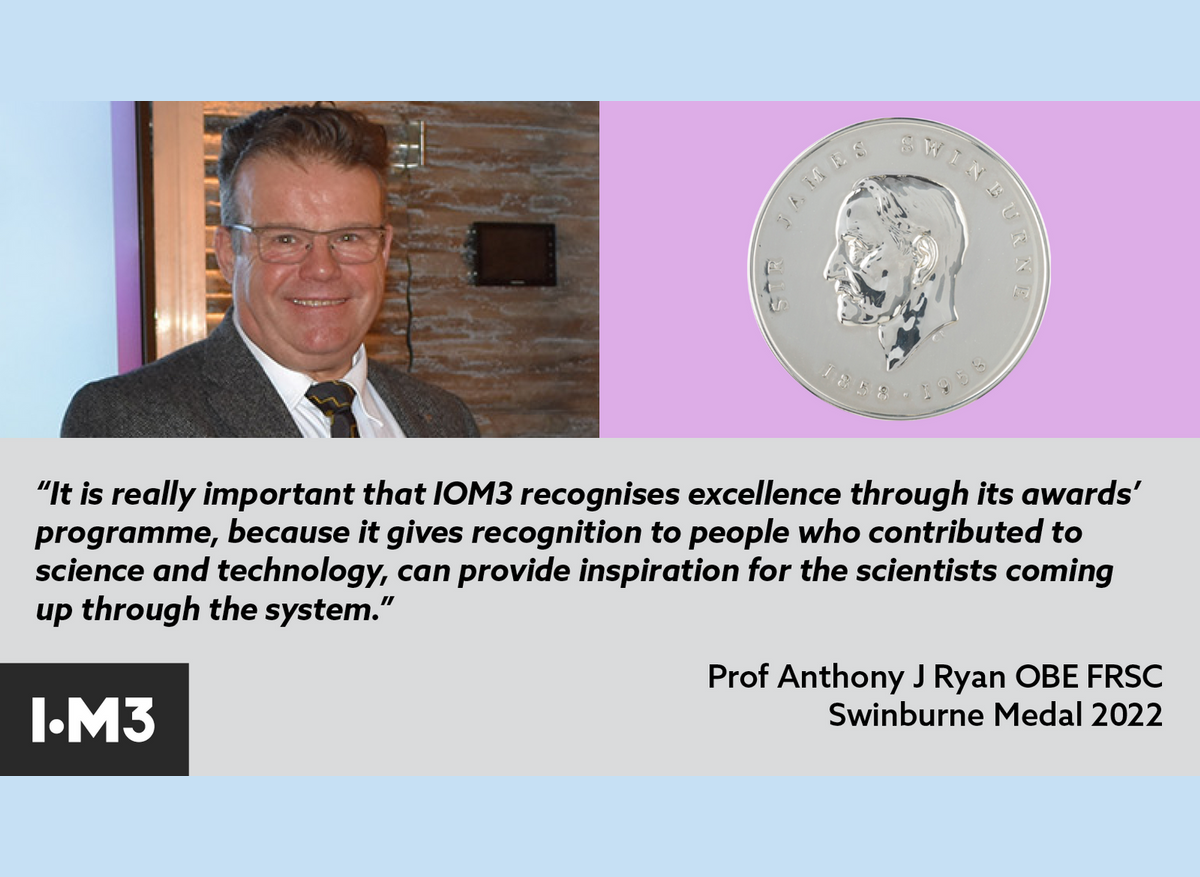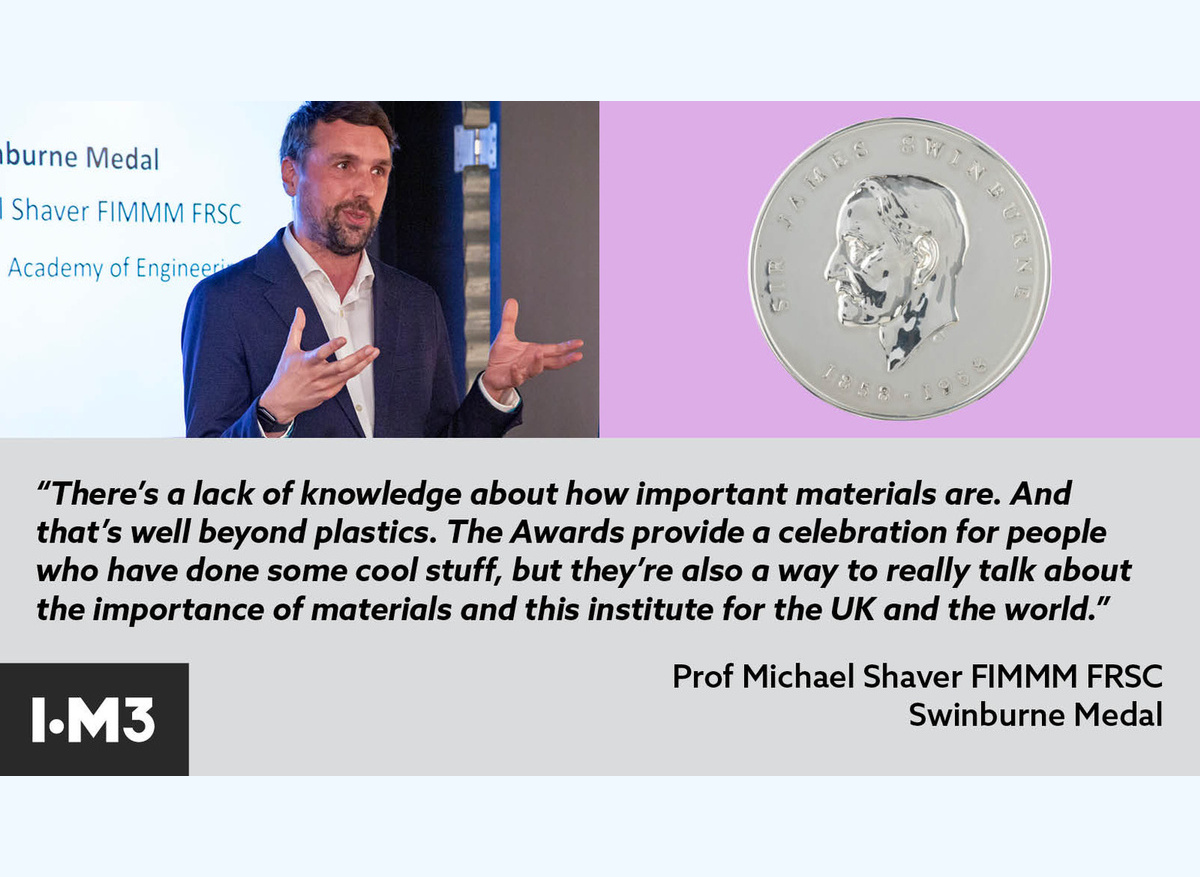Swinburne Medal (Not available in 2025)
The Swinburne Medal is presented in recognition of achievement of outstanding contribution to the advancement and knowledge of any field related to the science, engineering or technology of plastics.
It is a requirement of acceptance that the recipient shall prepare and deliver the Swinburne Lecture on an occasion selected by the Institute.
The winner will receive medal.
Given alternate (even) years, the recipient will be providing a lecture on their work in the intervening years.
Award judging
Past winners
2021 -
2024 Prof Michael Shaver FIMMM FRSC, 2022 Prof Anthony John Ryan OBE FRSC
2001 - 2020
2020 S J Eichhorn, 2018 C Bastiaansen, 2016 S Patrick, 2012 R Young, 2010 Prof Ton Peijs, 2008 Prof Phil Coates, 2006 M Gilbert, 2004 Prof J McN Courtney, 2002 Prof M H Wagner
1981 - 2000
2000 A F Johnson, 1998 C B Bucknall, 1996 Prof E J Kramer, 1994 Prof W J Feast, 1992 A H Windle, 1990 M J Bevis, 1988 I M Ward, 1986 J G Williams, 1984 J B Rose, 1982 G Menges
1961 - 1980
1980 G Allen, 1978 P W Morgan, 1976 H Schnell, 1974 A Keller, 1972 R F Boyer, 1970 L R G Treloar, 1968 H F Mark, 1966 C E H Bawn, 1964 K Ziegler, 1962 J C Swallow, 1960 G Gee
About Sir James Swinburne, Bart FRS
The award was instituted in 1959 by the then Plastics Institute to commemorate the life and work of Sir James Swinburne Bart FRS who was Chairman of Bakelite Ltd for many tears and President of the Plastics Institute from 1937 to 1938. The award was endowed originally by Bakelite Ltd and it is currently associated with BXL Plastics Ltd.
James Swinburne was the third of six sons born to Mary Swinburne (nee Fraser) and her husband Captain T A Swinburne R N.
He was educated at Clifton College where, as he was later to observe, his education was 'ordinary' except that his tutors included Rodnell (a chemist and Fellow of the Royal Astronomical Society), Perry (an accomplished mathematician, physicist and engineer, later Dean of City and Guilds) and Tilden (a chemist, later Sir William Tilden, FRS and Davy Medallist. There can be little doubt that this practical engineering skills and regard for the natural sciences were engendered in these formative years.
Swinburne & the electrical industry
Swinburne showed an early interest in the emerging electrical industry. His subsequent achievements in this field were outstanding. Among the accomplishments noted in his application for election to the Royal Society - countersigned by such distinguished names as Kelvin, Oliver Lodge and William Crookes - were: 'intimately connected with the development and theory of dynamo designs... developed the theory of armature reaction in d c machines and in a c dynamos and motors... development of the theory of a c measuring instruments...'
The early years of plastics
No less important was Swinburne's involvement in the early development of plastics in the United Kingdom. In 1902, Swinburne (now Sir James Swinburne, Brat FRS) was the consulting engineer with offices at 82 Victoria Steer, London. It was in that year in London that he first say a specimen of solid resin obtained from the reaction of phenol and formaldehyde by an Austrian chemist named Luft. Many considered the resin to be a curiosity of no commercial potential. Swinburne believed, however, that Luft's resin could be made to yield a useful material and, to undertake research and development of its properties, he formed in 1904 the Fireproof Celluloid Syndicate Limited.
The Syndicate discovered caustic soda to be a suitable catalyst but Swinburne delayed filling a patent for two or three years in the hope of finding a better method. When he did so in 1907, it was only to find that he had just been anticipated by Dr Leo Baekeland working in America. Baekeland called his material 'Bakelite' and his published work is generally regarded as a masterpiece of systematic investigation and as marking the birth of the modern plastics industry.
Although the Syndicate's solid resin was not completely successful, it did succeed in producing a lacquer suitable for coating brass and other polished metals. The lacquer, called 'Damard', was of particular value for coating the ball bedsteads then in vogue, and Swinburne decided to wind up the Fireproof Celluloid Syndicate Limited and concentrate on the production of solutions, including lacquers. In 1910, a new Company, the Damard Lacquer Company Limited, was formed with premises in Birmingham in the centre of the brass industry.
The steady growth of the Company from these modest beginnings, and its significant part in the early days of plastics, is now a matter of history. Baekeland and Swinburne became firm and lifelong friends. In Baekeland acquired the Damard Lacquer Company Limited which, together with certain other plastics interests, he merged into his recently formed Bakelite Limited. Swinburne was its first Chairman and in this office he continued until 1948 when he retired with the office of Honorary Life President.
Other interests and achievements
Swinburne's interests and achievements outside his main career were as remarkable as they were varied. He was acknowledged as an outstanding expert witness on patent law; a scientific consultant to General Motors; an authority on paper-bag machinery and the metallurgy of razor-blades; the inventor of an electrical incubator for hatching chickens; the author of controversial books on musical education for women and world over-population. He contributed to the discovery of the location of the famous sunken bullion ship 'Egypt'; coined the words 'rotor' and 'stator' still used today; was an authority on the mechanism of clocks and watches; and wrote poetry and music.
Perhaps the best summing up of the technical and scientific achievements of this remarkable and gifted centenarian is to be found in the following list of offices and distinctions he enjoyed throughout his long life:
- Fellow of the Royal Society 1906
- President of the Institution of Electrical Engineers 1902-3 and for 73 years a corporate member, an unequalled record
- President of the Plastics Institute 1937-8
- President of the Faraday Society
- President of the Junior Institution of Engineers. Member of the Institution of Civil Engineers
- Member of the Institution of Mechanical Engineers
- Member of the Council of the Royal Musical Association
- Member of the Physical Society. Fellow of the Chemical Society
The character of Swinburne
Swinburne's personal qualities matched his scientific achievements. The Biographical Memoirs of Fellows of the Royal Society, published in 1960 records him as being a man of the greatest integrity, courteous and well-mannered. Laconic in speech but an excellent talker and a very good listener, he was abstemious, being a teetotaller and non-smoker. His sense of humour was acute and he was passionately interest in the future.
It seems entirely in character that he should have achieved the final accolade of living to be 100 years old.
12 October 1981



